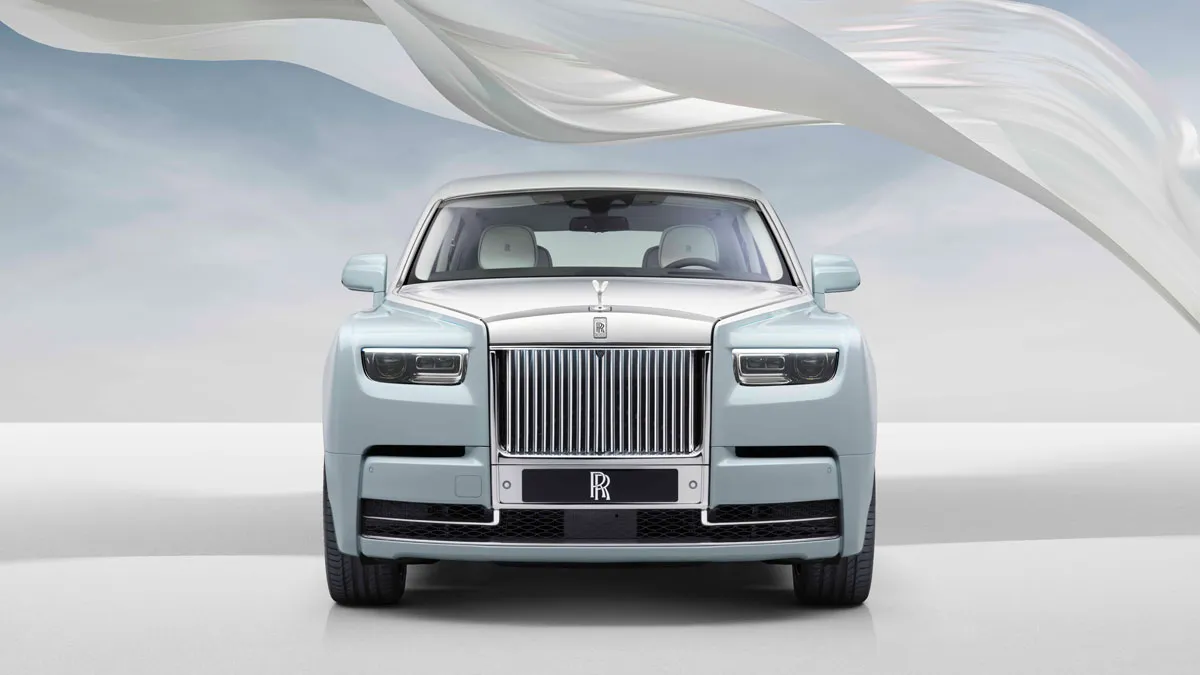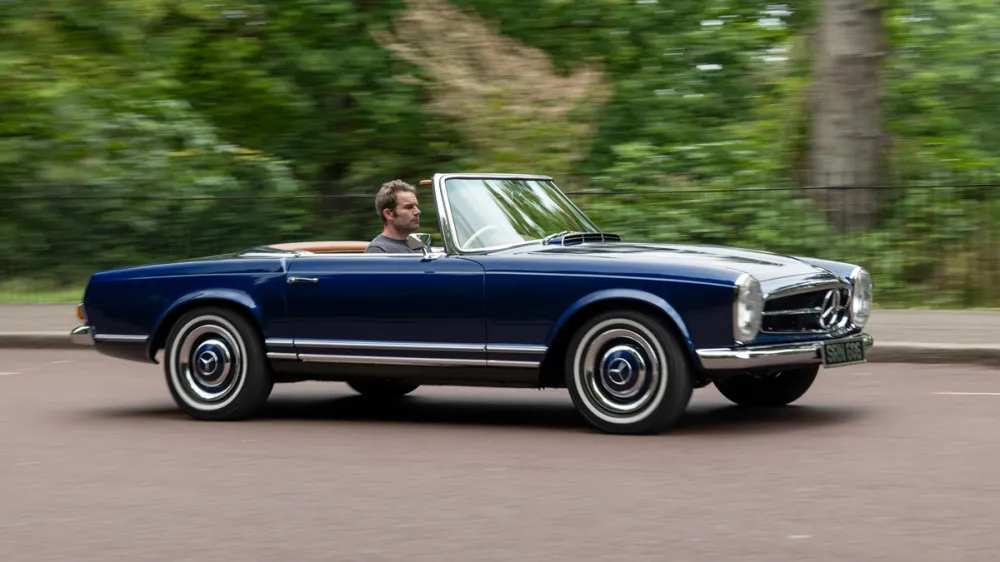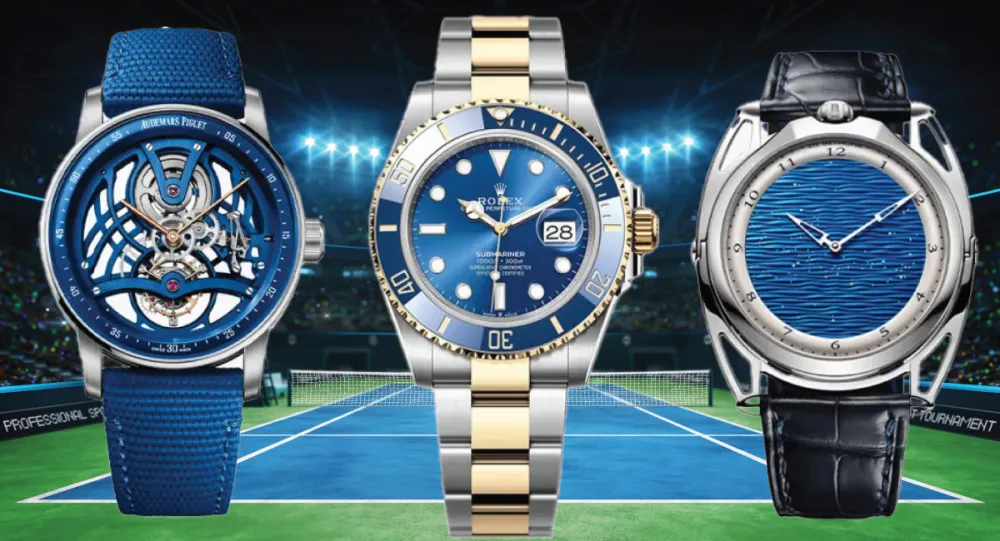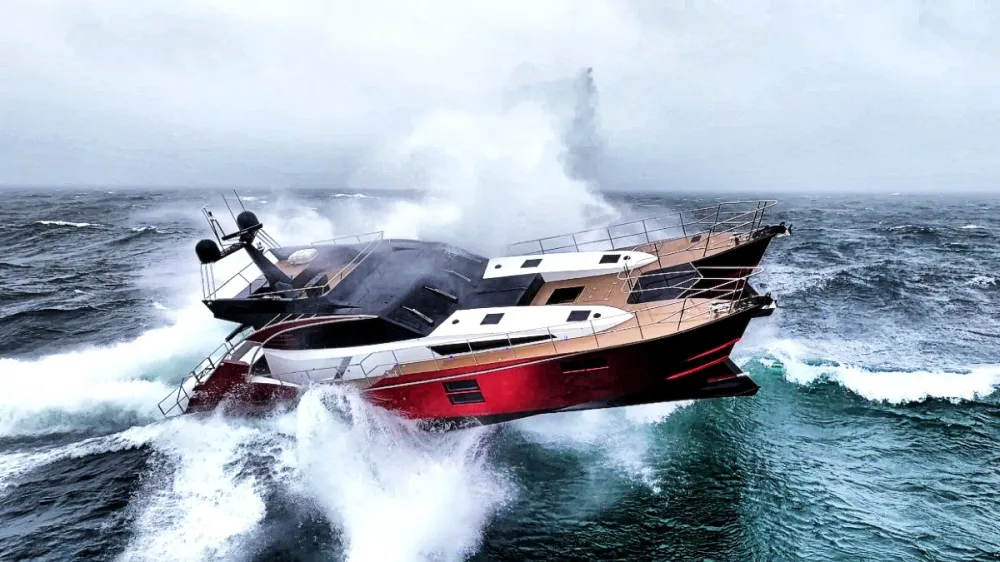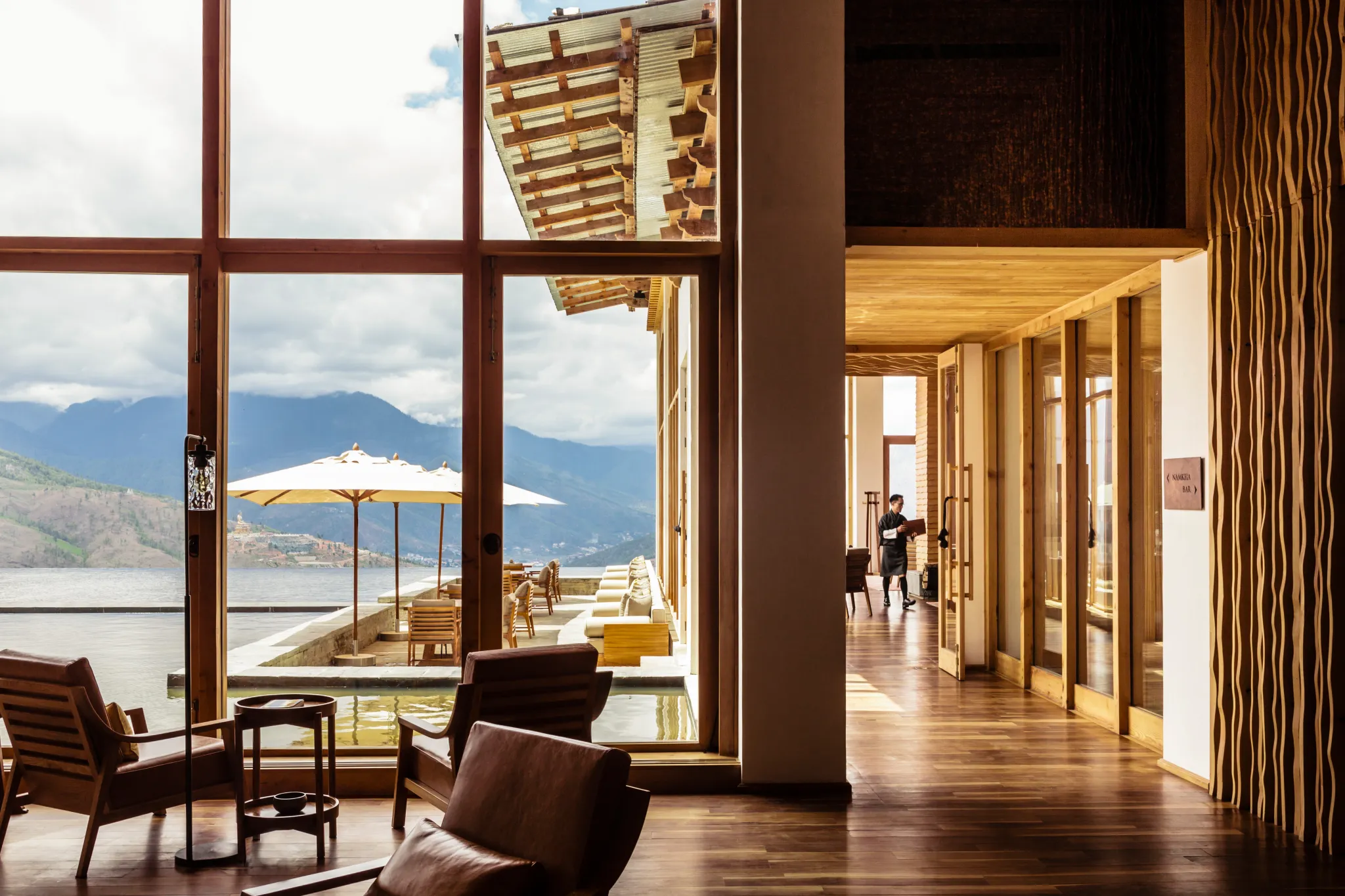
Robb Read: Why We’re For Crosskart Racing
A Day Of Dirt Buggies, Porches And Dual Terrain
Related articles
Coming down into Turn 1 on the Monticello Motor Club (MMC) track while at the top of sixth gear is always a tricky thing. You’re braking downhill, and a challenging right-hand turn sits at the very bottom of the straightway. Right now, an engine at a 13,200-rpm redline is keening behind my head; I’m hard on the brakes; and the right-hander is coming up fast.
But I don’t turn the wheel. Instead, the vehicle screams off the track onto the grass. I twist the wheel now, and go sideways on the turf before cresting a slight rise and blasting back onto the paved track. But, 20 seconds later, I plough off the track again, spitting dirt from my rear wheels.

Crosskart racing at Monticello Motor Club. Photo by Christopher Szczypala, courtesy of Monticello Motor Club.
First-time mistakes on a racecourse? Nope. I’m piloting a “crosskart” race car, a buggy-style machine with a single-seat, four knobby tires at each end and a 750cc motorcycle engine mounted in the rear.
Maybe all that social distancing made the folks at New York’s premiere (and highly manicured) private track even more imaginative. The team at Catskills-based Monticello took out some trees in the centre of its South Course, and turned it into a dirt-and-grass path that both intersects and joins up with the asphalt.
The result is a rallycross circuit that includes superfast, on-tarmac straights; a mad, blind dash up a dirt hill; and at least two potential jumps. Even better, they are making a wheel-to-wheel race out of the new course for members.

The new off-road track component at Monticello Motor Club. Photo by Christopher Szczypala, courtesy of Monticello Motor Club.
“We are calling it the Race of Champions,” says Ari Straus, the CEO of MMC. “It’s the ultimate ride-and-drive-spec racing series. Twelve drivers will race both Porsche Caymans and the rally buggies to decide who is the ultimate driver on every surface.”
The idea is audacious. The approx. $54,700 buy-in price, for the entire three-race season, includes both a Porsche—with a roll-cage—and the Speedcar Xtrem crosskart. All will be specified exactly the same, and competitors will be assigned a car at random, negating any potential performance advantages.

Writer Jason H. Harper stands next to a Speedcar Xtrem for sense of perspective. Photo by Christopher Szczypala, courtesy of Monticello Motor Club.
On the first half of race day, the dozen drivers will be broken into heats, and each will race three times in the Cayman, accumulating points. On the second half, they will race three more times in the buggies. Yeah, you read that right: Six races in a single day. “Sound like too much?” asks Straus. “Then the series is not for you.” At the end of the season, an overall winner will be crowned.

Listening to last-minute instructions before letting loose. Photo by Christopher Szczypala, courtesy of Monticello Motor Club.
“Since we’ve opened, we’ve sent a couple dozen members to semipro and pro racing series,” says Straus. “But those series are really expensive to run, and take up a lot of time travelling around the country. This is a chance to do something unique, bringing some of those racers back. It’s also going to have a ‘big show’ kind of spectacle to it. Can you imagine those buggies racing in the dirt side by side?”

The club’s rallycross-style circuit includes on-tarmac straights, a dirt hill and at least two potential jumps. Photo by Christopher Szczypala, courtesy of Monticello Motor Club.
The crosskarts, built in Spain and hugely popular in Europe, are intensely fast. They have sequential gearboxes which require use of a clutch. There’s a handbrake, too, if you want to get seriously sideways, rally style.

Made in Spain, the single-seater has a sequential gearbox, which requires use of a clutch. Photo by Christopher Szczypala, courtesy of Monticello Motor Club.
During my very first session on an afternoon in June, the skies open up with rain and water beads on my helmet’s visor as I pummel down the track. (There are no front windows, only metal screens.) Surprisingly, the traction is sure and grippy, even on wet tarmac. As soon as the buggy hits dirt, though, I find I can toss it around, drifting with the addition of left-foot braking.
But then I watch as two buggies take on the course simultaneously, piloted by MMC’s resident rally expert, Chris Duplessis, and an Irish rally driver, Barry Mckenna (who imports the buggies for the club).

The Speedcar Xtrem has a 750cc motorcycle engine mounted in the rear, making the vehicle extremely fast. Photo by Christopher Szczypala, courtesy of Monticello Motor Club.
The speeds they carry onto the grass and back onto the track are incredible. At one point, they’re both literally in the air, sideways. They somehow land upright and carry on.
“You may find this is the most fun you’ve ever had on four wheels,” says Straus, later, as I drip sweat and rain water. He just might be right.
Subscribe to the Newsletter
Recommended for you
Rolls-Royce Debuted the New Phantom Scintilla at Monterey Car Week. Here’s Everything We Know.
Limited to 10 examples, each car has an interior defined by “painting with thread,” and a rumored price of around $2.6 million.
September 3, 2024
First Drive: This 1968 Mercedes-Benz ‘Pagoda’ SL Is an EV Restomod That’s Better Than the Original
Electrified by Everrati, the 230 SL hits 96 mph in 7.0 seconds and has a 320-mile range while staying true to the model’s original ethos.
By Tim Pitt
August 27, 2024
You may also like.
10/09/2024
You may also like.
This Collection of Lavish Private Estates Is Ready for Your Next European Vacation
From a contemporary château on the French Riviera to a palazzo on the shores of Lake Como.
Forget a resort. On your next European jaunt, you’ll have a slew of stylish estates where you can rest your head.
Luxury travel company Red Savannah just unveiled its Ultimate Estates collection, an assembly of private vacation rentals scattered across Italy, France, Greece, and Spain, to name a few. The 21 properties essentially function as a five-star hotel, with the added bonus of not having to share your space.
Want to stay in an English manor in the Cotswolds? How about a beach club-inspired villa in Ibiza? You can expect to find a minimum of six bedrooms no matter the booking, plus epic amenities like spas, private boats, gyms, tennis courts, wine cellars, and home movie theaters. In addition, each reservation comes with a full team of staff including chefs and a 24/7 concierge contact.
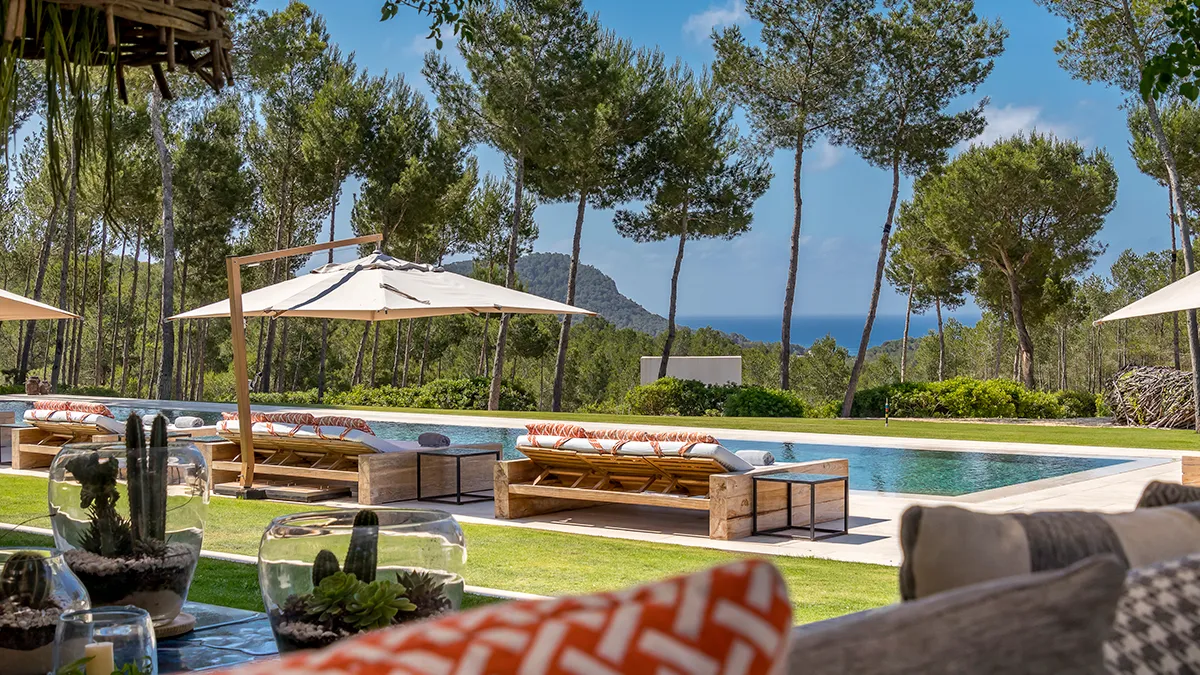
Red Savannah
“These highly experienced travel specialists act as personal travel assistants to organize bespoke itineraries, secure one-of-a-kind experiences, and ensure a flawless stay,” Red Savannah said in a statement. “Past arrangements have included delivering a Steinway grand piano by helicopter to Villa La Cassinella and arranging for a soprano from Milan’s La Scala to serenade guests during dinner on a wisteria-draped terrace overlooking Lake Como.”
For bigger parties and a glitzy beach-club vibe, look no further than the 10-bed Villa Xi on Ibiza. At the property—which is just down the road from the iconic Blue Marlin on Cala Jondal—you and your family can tuck your toes in a sandy bar area nestled underneath pine trees and, by night, hang by the palm-shaded Jacuzzi. The villa’s generous 10 acres offer up plenty of opportunities to stay active, from playing volleyball to swimming in the over-80-foot pool. The villa itself was recently completed in 2017 and is decked out with modern interiors that merge Scandinavian and Indonesian designs: Think en-suite bedrooms with Balinese-style showers and tropical shrubs.
Nestled in the heart of the French Riviera on the Cap d’Antibes, Red Savannah’s Domaine de la Garoupe is perfect for smaller groups perhaps seeking a respite from the famous Hotel du Cap-Eden-Roc. The château has nine total bedrooms, split between a main house (known as La Palombière) and two separate dwellings dubbed La Maison du Cap and La Petite Palombière. Altogether, the abode can sleep up to 18 guests and packs a ton of perks such as a private spa, a salon for hair and nail treatments, a gym, a wine cellar, and a 15-seat cinema. La Palombière acts as the property’s hub with a marble-clad kitchen, a drawing room overlooking the garden, and an outdoor swimming pool.
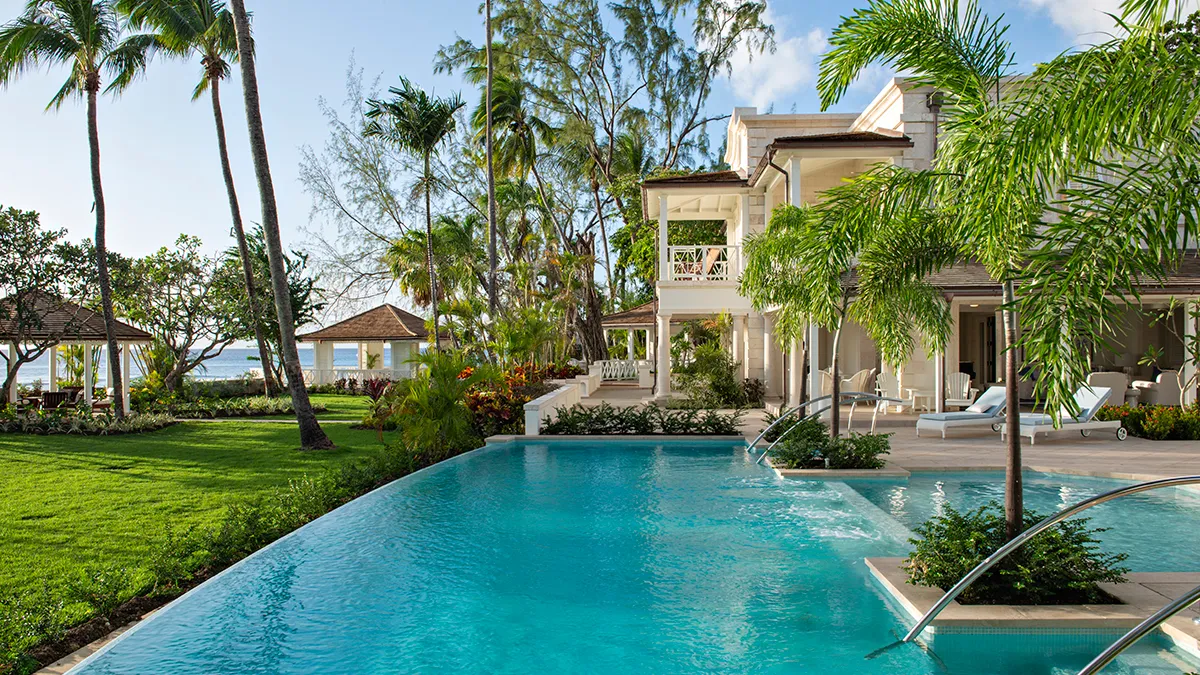
Red Savannah
If you’re looking for something with say, a tropical flair, the Ultimate Estates collection includes the Caribbean, too. There’s a massive 12-suite spread in Barbados planted right on the beach on the island’s northwest coast. The Great House, as it’s known, can sleep up to 30 people between its main digs, the Hillaby House, and two cottages. However, you’ll most likely spend a lot of time outdoors enjoying the alfresco perks. Chief among them is a beach bar with a pizza oven, a 33-foot motorboat, kayaks, and water toys.
As for any non-estate escapes, Red Savannah’s got you covered there, too. One of its newest itineraries will let you explore Marrakech just like Yves Saint Laurent, or you can opt for a litany of literary-themed activities in the brand’s In the Footsteps of the Great Detectives series.
You may also like.
10/09/2024
The 8 Best Watches of the U.S. Open, From Jannik Sinner’s Rolex to Serena Williams’s Audemars Piguet
From Federer’s Rolex Le Mans Daytona in Yellow Gold to Pegula’s De Bethune DB28XS Purple Rain, players past and present brought their A-game to the final Grand Slam of 2024.
Watches and tennis are a match made in heaven. It likely comes as no surprise that players past and present would have some major wrist game at the Grand Slams. Each year, the U.S. Open closes out the season with a bang, and everyone seems to pull out all the stops for the occasion. Fans have set a new record booking the infamous suites (which can cost up to $149,000), and luxury brands like Tiffany & Co. have firmly planted their presence on the grounds with pop-up activations. As a major sponsor, Rolex, of course, is omnipresent. Come August, Flushing Meadows is the place to see and be seen, and with the close ties between timepieces and tennis, the watch spotting never fails to disappoint on and off the court. Here are eight of the coolest watches we’ve seen at the 2024 U.S. Open.
Roger Federer in a Rolex Le Mans Daytona in Yellow Gold

Last year, Rolex dropped a watch that made major waves. In honor of the 60th anniversary of the beloved Daytona and the 100th anniversary of the iconic 24 Hours of Le Mans endurance race, the Crown unveiled a special edition model: the Cosmograph Daytona Celebrating 100 Years of Speed. Just shy of a year after its debut, Rolex announced it’d be discontinuing the model at Watches & Wonders 2024, while quietly replacing it with a yellow gold version. This illusive yellow-gold replacement has left much to the imagination, barring some texted contraband images we saw at Watches and Wonders in April, but now it’s plain as day. At the quarterfinal matches, Tennis legend and longtime Rolex collector Roger Federer was spotted wearing the coveted model.
Jessica Pegula in a De Bethune DB28XS Purple Rain
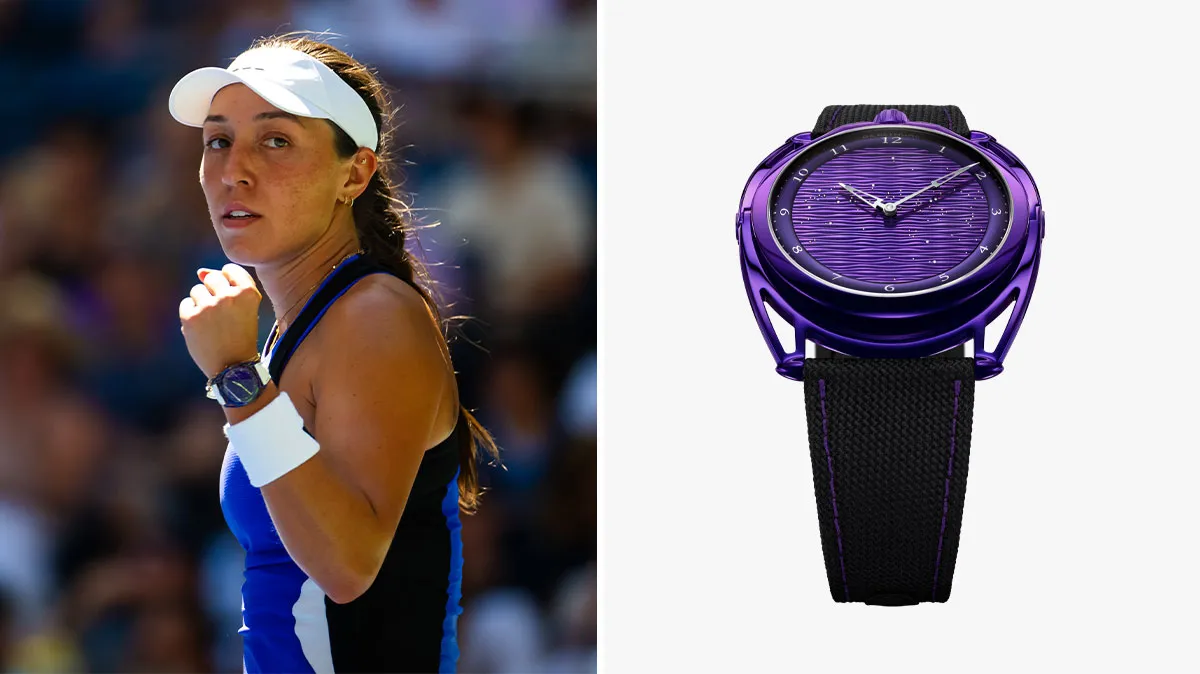
Number six ranked Jessica Pegula has held her own for the U.S.A in this year’s U.S. Open. The New York native has made it to the quarterfinals at Flushing Meadows for the second time in her career but is still yet to land a Grand Slam win. Off the court, it’s yet to be seen how deep Pegula’s watch collection goes, but one thing is for certain: She has a particular affinity for one brand, and it shows the young player has interesting taste in timepieces. Her brand of choice? De Bethune. Pegula has been spotted wearing various models from the brand, including the DB28xs Starry Seas. However, this year, she’s been rocking the DB28XS Purple Rain that debuted at Watches & Wonders earlier this spring.
Jannik Sinner in a Rolex Submariner Date
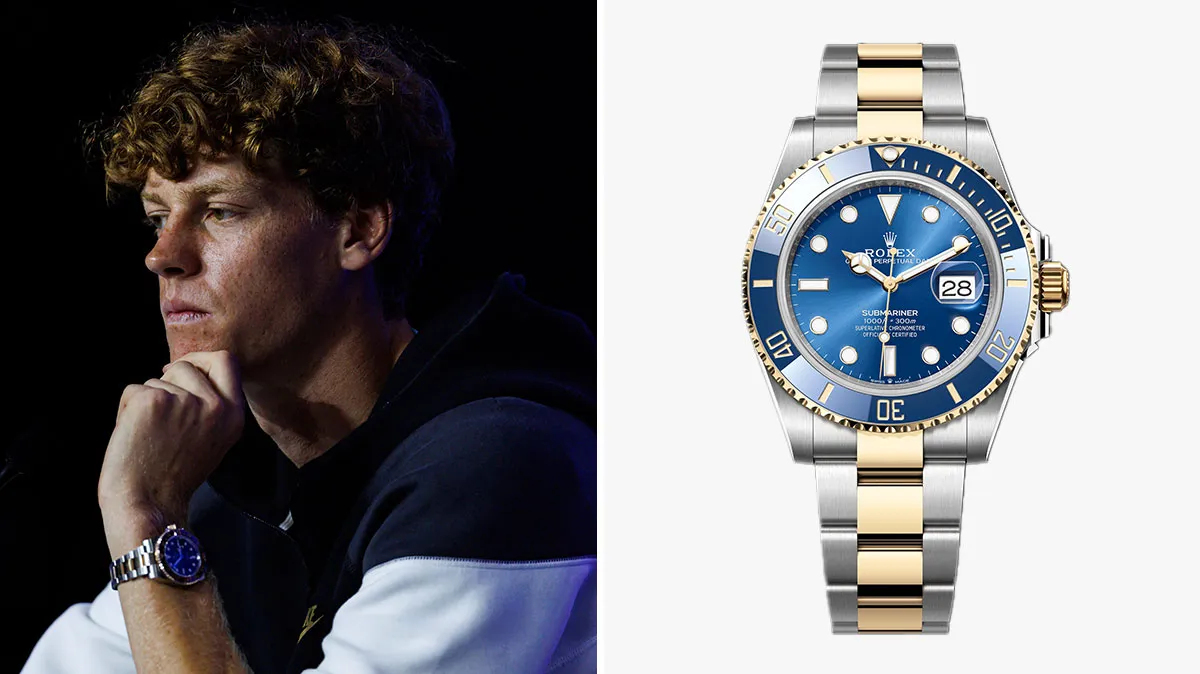
With major upsets for Carlos Alcaraz and Novak Djokovic early on in the tournament, this year’s U.S. Open is Jannik Sinner’s to win. The young Italian player is currently ranked number one in the world ahead of Djokovic, Alcaraz, and Alexander Zverevs. Luckily for Sinner, he has Rolex on his side. At last year’s U.S. Open, Coco Gauff won in women’s singles, proudly accepting her trophy with the discontinued Rolex ‘Red Grape’ on her wrist, so perhaps the luck will wear off on Jannik. Sinner has been a Rolex ambassador since 2020, and his current model of choice is a classic two-tone Submariner Date with a blue dial.
Andrey Rublev in a Bulgari Octo Finissimo Tourbillon Skeleton Ceramic
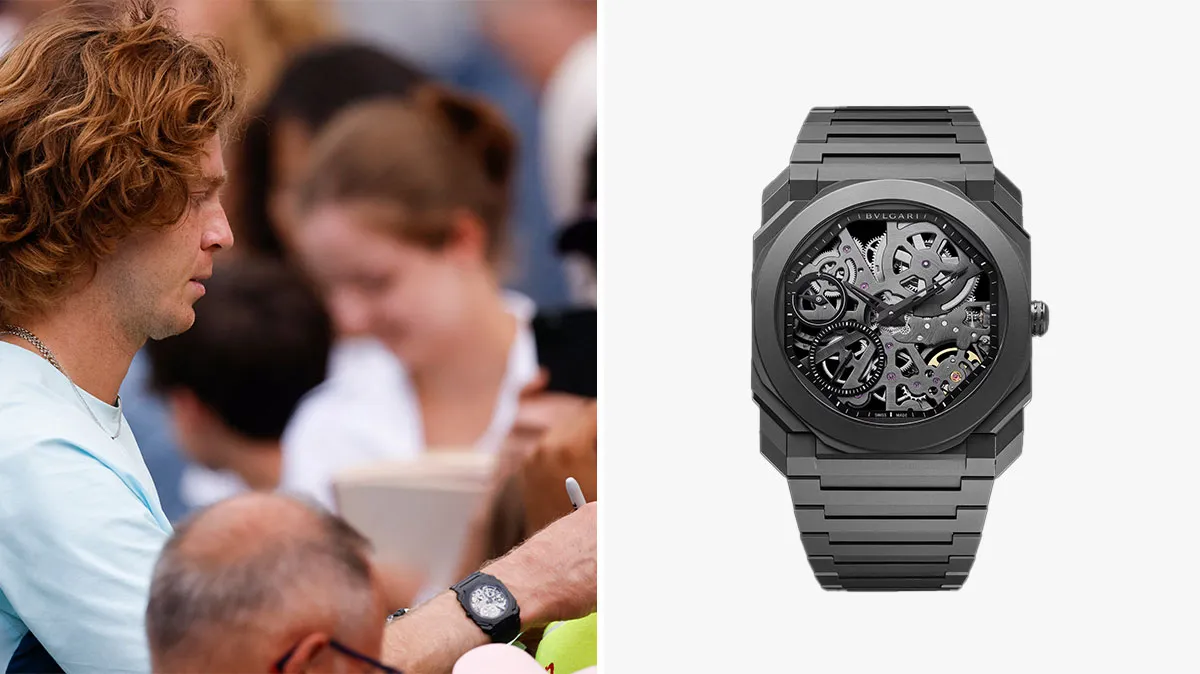
Russian tennis pro Andrey Rublev was knocked out of this year’s U.S. Open in the round of 16 by the Bulgarian player Grigor Dimitrov, who later went on to lose to American tennis star Frances Tiafoe in the quarterfinals. Despite the upset, Rublev came to the tournament with a major wrist flex. Back in 2021, Rublev became Bulgari’s first-ever tennis ambassador, and since then we’ve seen him sport a number of models from the Roman Maison. For this year’s Grand Slam at Flushing Meadows, he opted for a pretty unique iteration from one of Bulgari’s most beloved collections. In the past decade, the brand has become synonymous with its Octo Finissimo line thanks to models shattering a whopping nine world records. Withing the collection, Rublev chose a ceramic version with a skeletonized dial and a tourbillon.
Tommy Paul in a De Bethune DB28XS Starry Seas
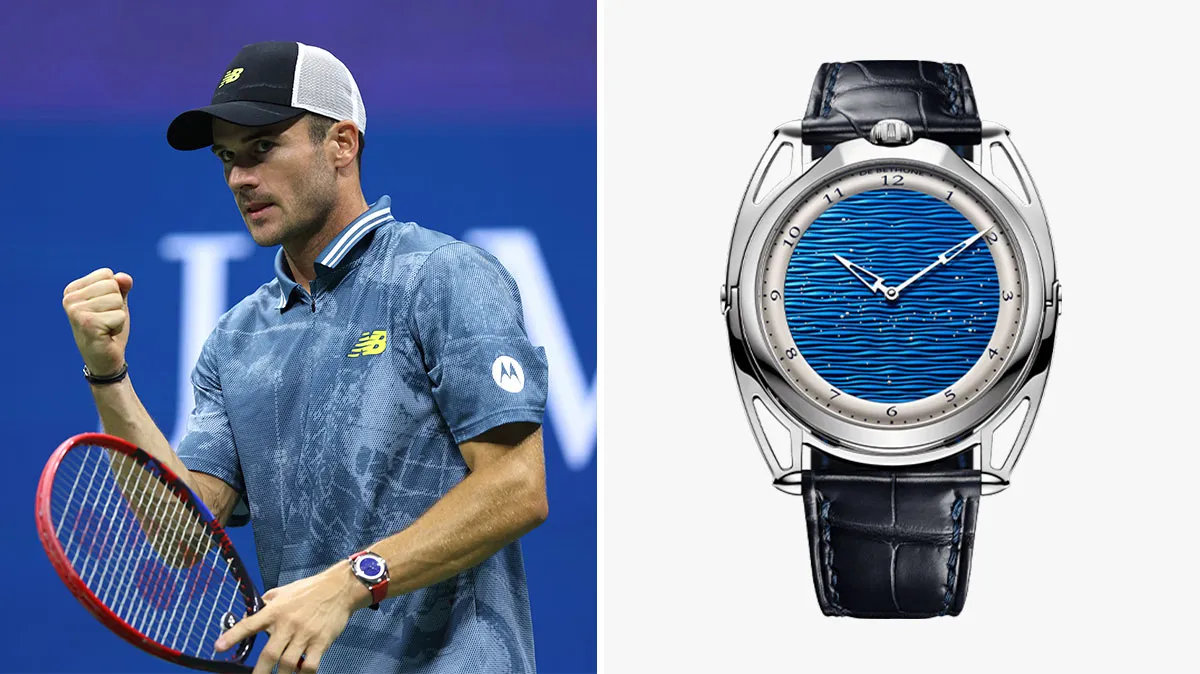
Who knew that De Bethune’s unconventional designs would be so popular among tennis pros? American player Tommy Paul became an ambassador for the brand just last year, with the pair announcing their official partnership during the 2023 Wimbledon tournament. Paul got knocked out by number one ranked Sinner in the round of 16 at this year’s U.S. Open, but he did so in style, of course, rocking a model from De Bethune. The DB28XS Starry Seas appears to be one of his particular favorites, and for good reason. When the model debuted last spring, it marked the world’s first random guilloche pattern along with new sweet-spot sizing at 39 mm.
Naomi Osaka in a TAG Heuer Aquaracer Limited Edition Naomi Osaka
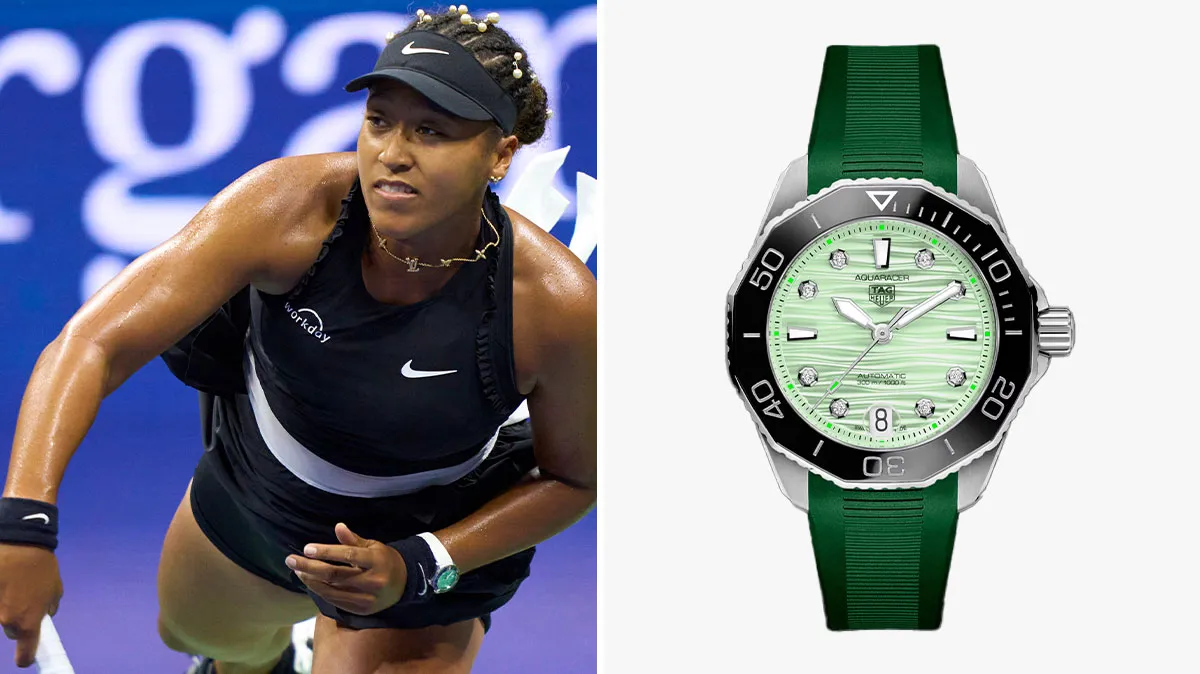
Like Alcaraz and Djokovic, the young Japanese tennis pro Naomi Osaka was upset in an early round at this year’s U.S. Open. Despite her run being short lived, she still had a chance to put her collaboratively designed timepiece on full display. The four-time Grand Slam winner has been a TAG Heuer ambassador since 2021. A year later, she partnered with the brand to co-design her own watch, resulting in the TAG Heuer Aquaracer Limited Edition Naomi Osaka. We know green dials have continued to be all the rage the past few years, and Osaka was early to catch on to the trend, which started gaining traction three years ago. For the customized Aquaracer bearing her name, she chose light green for the dial and a darker green for the rubber strap.
Donna Vekic in a F.P. Journe Elegante 40
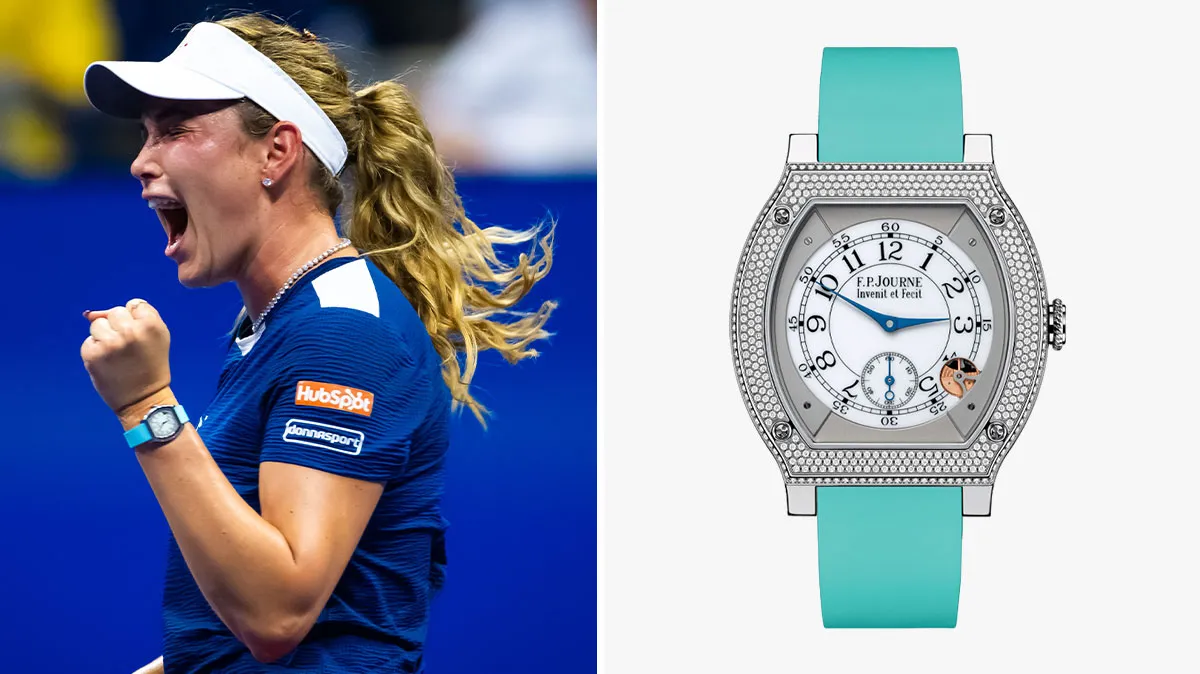
Croatian tennis pro Donna Vekic may be a lesser known player on the circuit. Back in 2019, she notched her career-high singles ranking just cracking the top 20 in at number 19. That same year, she made it to the quarterfinals at the U.S. Open. While she wasn’t as successful at this year’s tournament, losing to the Chinese player Zheng Qinwen in the round of 16, she certainly took her defeat in style. We’ve yet to see the full breath of Vekic’s watch collection, or perhaps she’s simply devoted to one brand—but a killer brand at that. She’s been spotted on countless occasions on and off the court wearing every color of the F.P. Journe Elegante 40 under the rainbow. At Flushing Meadows this year, she opted for the gorgeous turquoise blue version.
Serena Williams in an Audemars Piguet Code 11.59 Blue Tourbillon
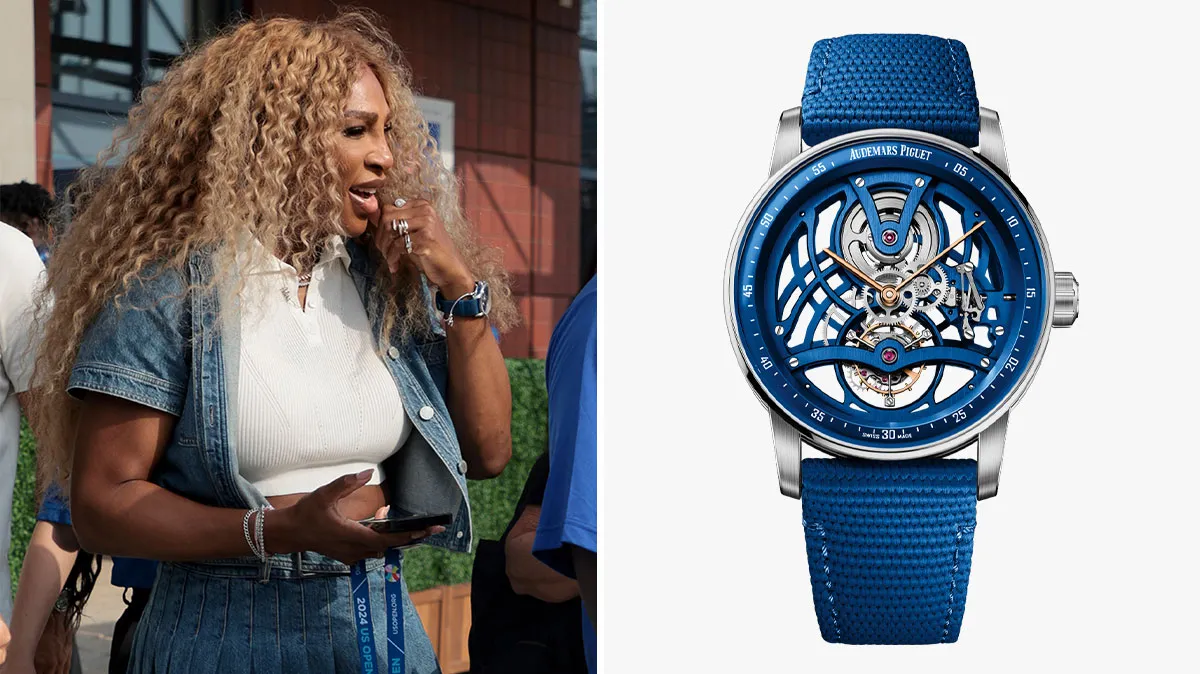
Like Federer, Serena Williams has been enjoying this year’s U.S. Open from the sidelines, cheering on the current players. It’s no secret Williams is a longtime ambassador and fan of Audemars Piguet, sporting countless models over the years from the tennis court to the red carpet and beyond. The former number one player and 23-time Grand Slam winner never ceases to keep us on our toes with which model from AP she’ll choose, sometimes opting for an ultra-sporty look and other times rocking a fully blinged out gem-set model. In the stands at Flushing Meadows, Williams chose the Code 11.59 Blue Tourbillon. The model came in 2022 featuring a fully blued-out design, from the ceramic mid-case to the hand-wound, open worked caliber 2948.
You may also like.
10/09/2024
Rolls-Royce Debuted the New Phantom Scintilla at Monterey Car Week. Here’s Everything We Know.
Limited to 10 examples, each car has an interior defined by “painting with thread,” and a rumored price of around $2.6 million.
Visitors to the fabled Louvre Museum in the heart of Paris might remember an exquisite marble sculpture standing proud at the top of the main Daru staircase. Named the Winged Victory of Samothrace, this eight-foot-tall headless goddess—with gossamer wings—dates to 190 B.C.
What has it got to do with Rolls-Royce’s new Phantom Scintilla Private Collection limousine, unveiled during this year’s Monterey Car Week? A lot, in fact. Rewind to 1910 and Rolls-Royce’s managing director at the time, Claude Johnson, who reportedly commissioned well-known sculptor Charles Sykes to create a hood ornament to define the new Rolls-Royce brand. Apparently, Johnson had seen the statue during a visit to the Louvre and fell in love with it.
While a change in direction saw Sykes create the Spirit of Ecstasy, inspired by Johnson’s former secretary, English actress and model Eleanor Thornton, the Louvre statue was always considered by Goodwood to be the original inspiration for its now iconic emblem.
So, when Rolls-Royce designers looked for a muse for a 10-car, Phantom-based Private Collection series to be called Scintilla—derived from the Latin word for “spark”—the marque went back to the Winged Victory of Samothrace statue and its Mediterranean roots.
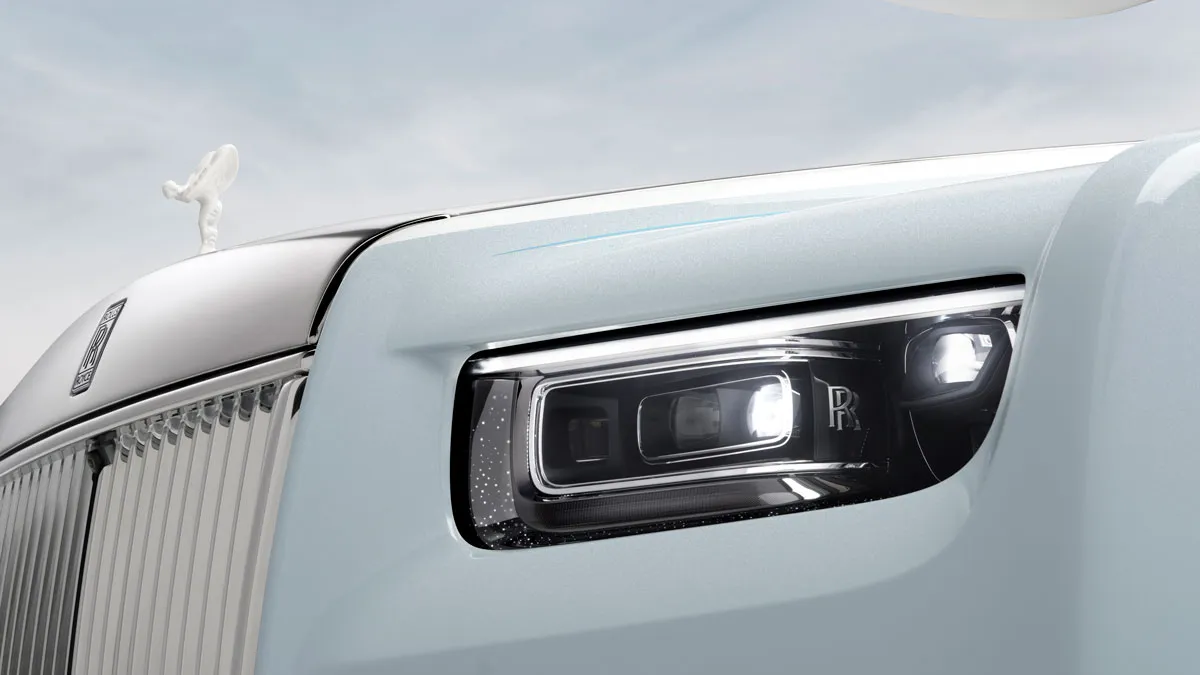
You see that influence in the car’s Spirit of Ecstasy figurine which, for the first time, features a translucent white, marble-like ceramic coating. It also carries over in the car’s two-tone paintwork—Andalusian White for the upper body, and powdery Thracian Blue, inspired by the color of the Med, for the lower section. A subtle metallic flake in the paintwork is said to mimic the sparkle of sunlight off the water.
Yet as with most bespoke and special-edition Phantoms, it’s the interior where Rolls-Royce craftsmanship is truly exhibited. In this case, the theme is exquisite embroidery or, as the automaker calls it, “painting with thread.”
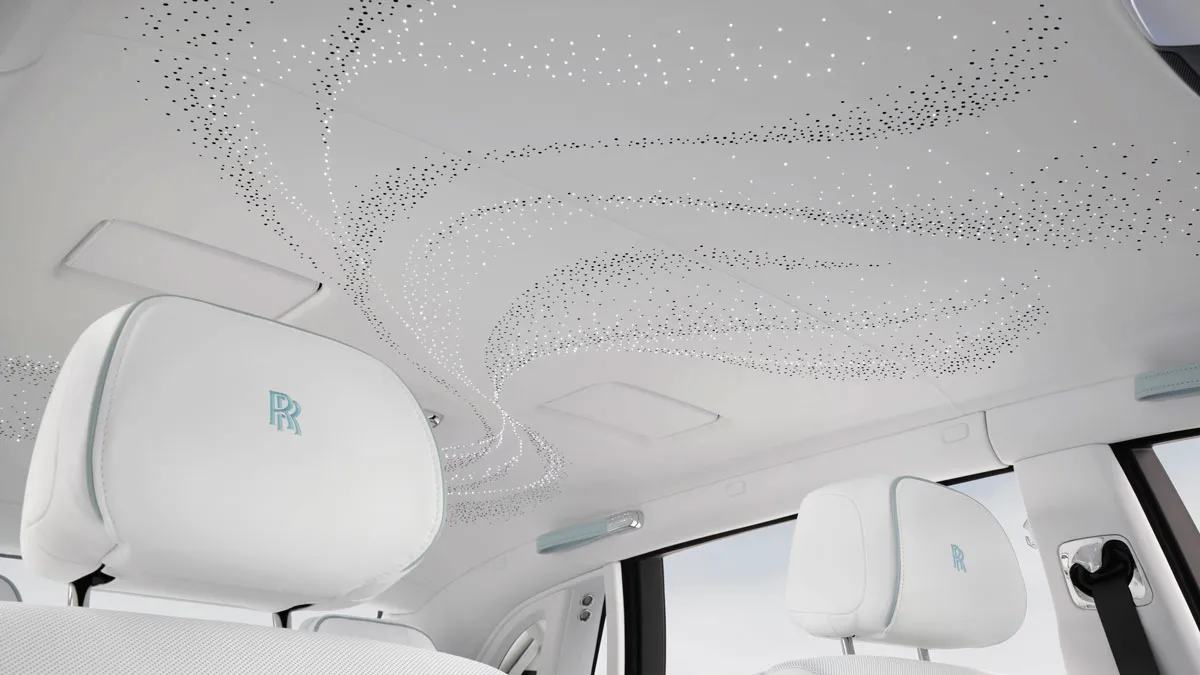
For Scintilla, the embroidery work involves over 850,000 individual stitches. And at night, illuminated perforations in the material give the doors a wave-like glow. In Phantom tradition, there’s a Starlight Headliner in the roof, but here, more than 1,500 fiber-optic illuminations twinkle in sequence to mimic silk billowing in a breeze.
The centerpiece of the interior is the Phantom’s dashboard gallery ahead of the front-seat passenger. Named “Celestial Pulse,” it comprises seven metal ribbons, each individually milled from solid aluminum and given the same finely grained ceramic finish as the Scintilla’s Spirit of Ecstasy.
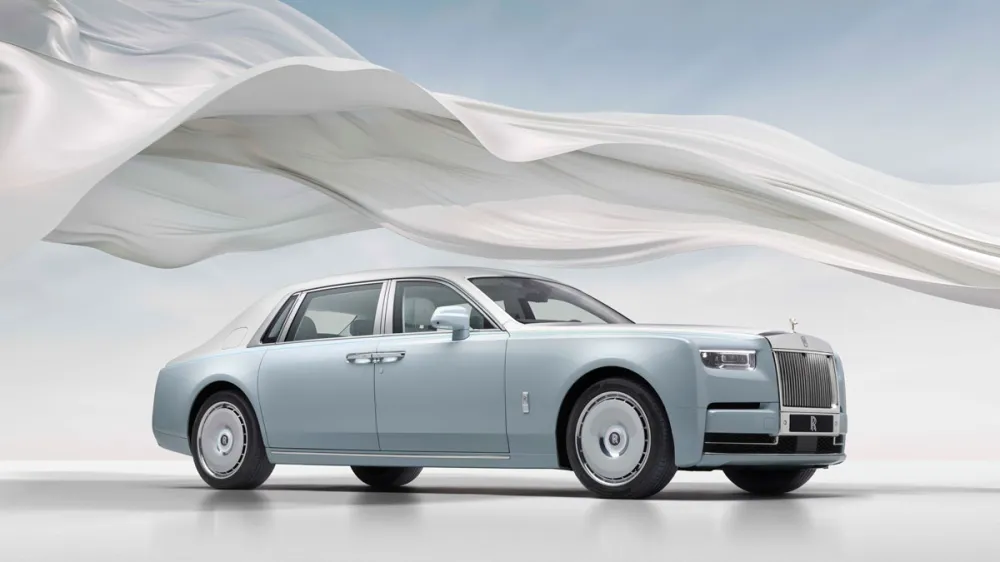
Rolls-Royce will build only 10 examples of the Phantom Scintilla, which had its public debut at the Quail, a Motorsports Gathering on August 16. Of that already small number, three will come to North America and, like the other seven, have already been sold. While there’s no official word on pricing, the figure $3.8 million has been reported.
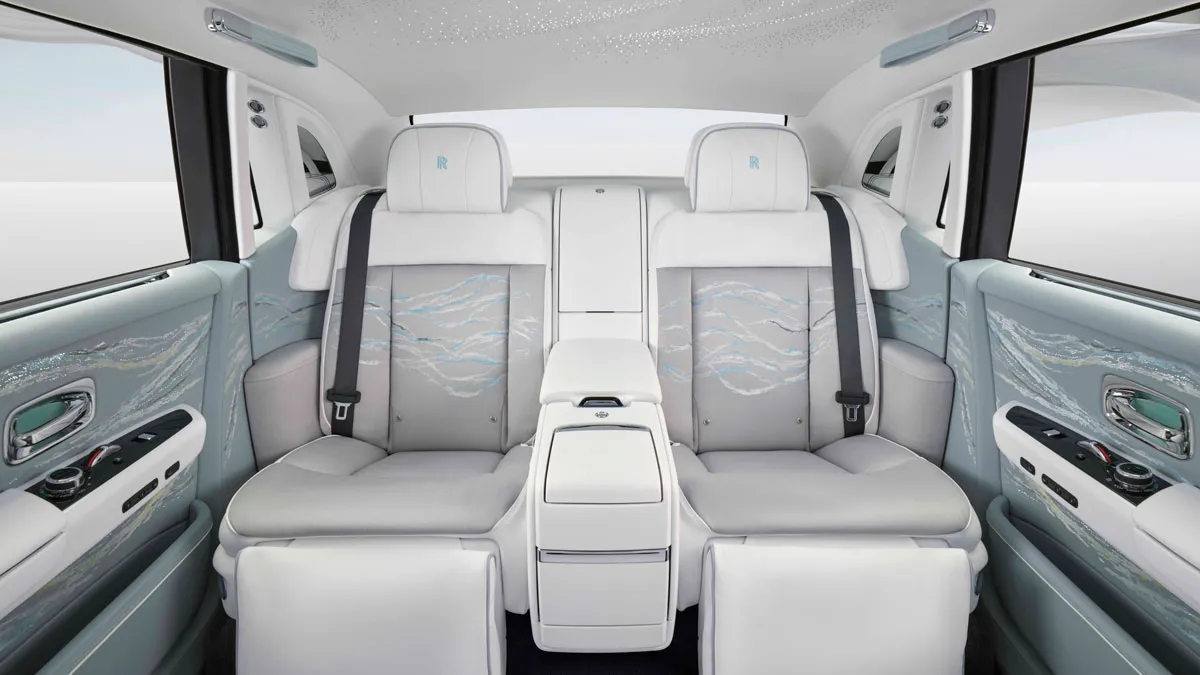
“With every collection, we aim to tell the story of Rolls-Royce Motor Cars and provoke our clients’ imagination, letting them know our Bespoke designers’ artistry is greater than they can envision,” stated Martin Fritsches, president of Rolls-Royce Motor Cars for the Americas, when asked for a comment by Robb Report. “We can’t think of a better way to tell this story than through the history of our idol, the Spirit of Ecstasy.”
You may also like.
10/09/2024
This Speedy 70-Foot Power Catamaran Is Designed to Cut Through Rough Waters
The 70-foot T-2000 Voyager can hit 60 mph in flat conditions, and then take waves up to 30 feet.
Back in April, Storm Kathleen slammed into the west coast of Ireland as a fearsome Force 10 gale, packing 112 kph winds and 15-foot waves. While locals sandbagged their homes and prepared for the worst, Frank Kowalski decided it was a swell day for a boat ride.
As owner of Safehaven Marine in County Cork, he’d just launched his brand-new, 70-foot T-2000 Voyager all-weather power catamaran. What Kathleen offered was a chance to put the new super-cat through its paces.
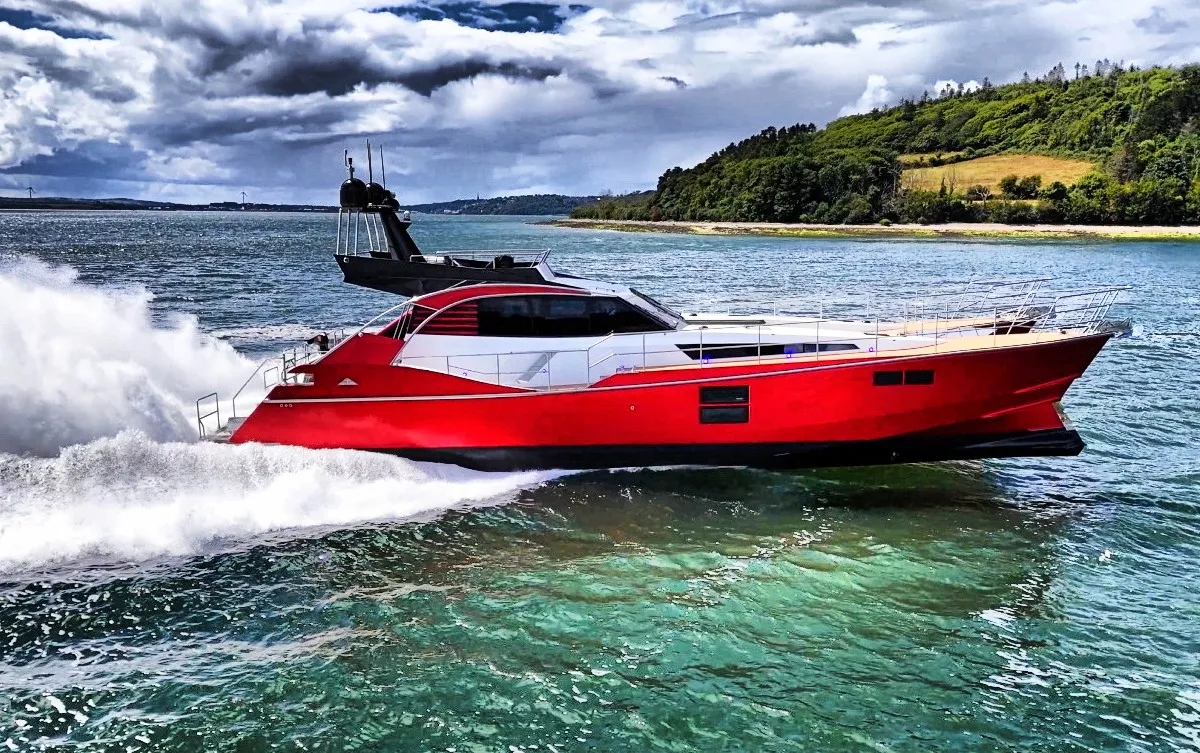
“We knew from scale-model tests that she should be able to tackle waves of more than 65 feet high,” Kowalski tells Robb Report. “But you never know until you’re out there. In the height of the storm, she just shrugged off the waves and weather and performed flawlessly.”
Evolved from Safehaven’s 75-foot XVS20 monohull launched in 2018, Kowalski used his expertise in building commercial, work-boat power catamarans to design the twin-hulled T-2000 Voyager to offer speed with stability.
“The stability in beam seas is what’s key here,” he says. “While we were out recently in a Force 8 with 40-plus knot winds and 12-foot seas, we were able to stop and leave the boat to drift while we retrieved a drone. It just took the waves on the beam with ease. In a monohull, it would have been rolling so badly you couldn’t have stood on the deck.”
Then there’s the sheer velocity that comes with twin, scalpel-thin hulls slicing through waves. With the T-2000’s pair of 1,550 hp MAN V12 diesels driving France Helices SD5 surface drives, the Safehaven can hit a top speed of 91 kph.
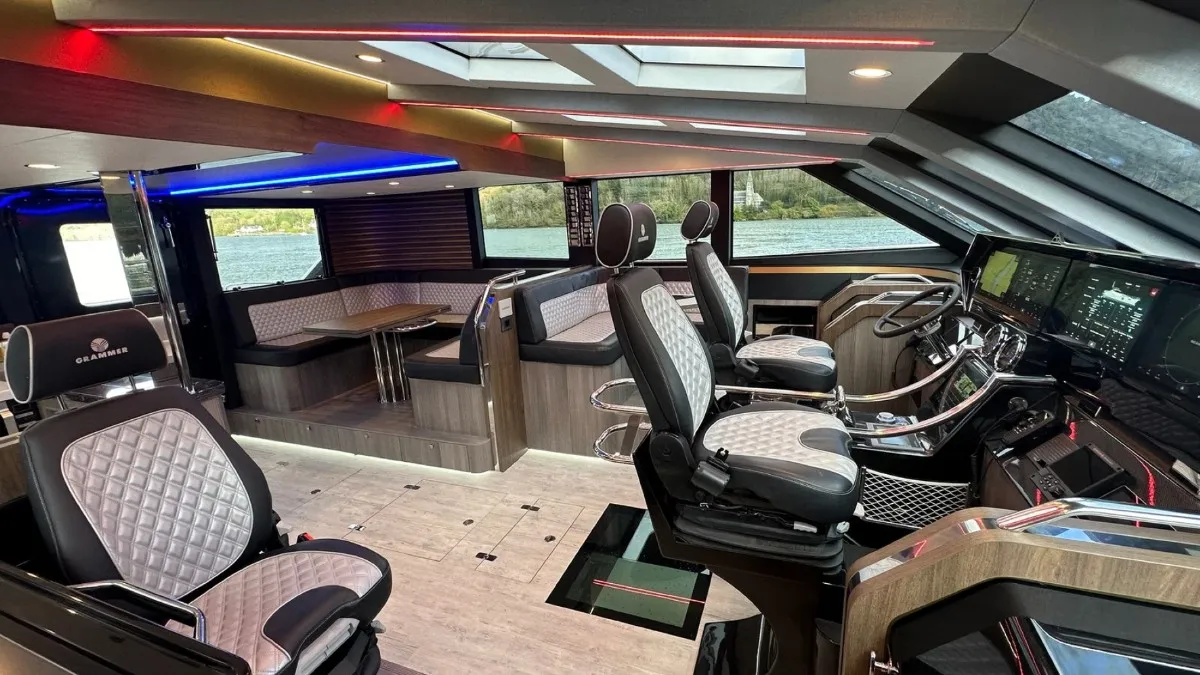
“It’s just the most amazing sight, standing on the stern, watching these huge roostertails behind,” Kowalski adds. “We’ve also incorporated retracting swim platforms so you can see the props spinning on the surface, plus valved exhausts that switch between silenced and straight-through. The noise from those V12s is sensational.”
While Safehaven has been building its Wildcat range of 40-, 53-, and 60-foot power cats for everything from oil-rig support, crew transfer, and even as a military cruiser for Britain’s Royal Navy, they were always pure, no-frills work boats. With this new T-2000, Kowalski is looking to appeal to private buyers searching for something a little different.
His hull No. 1 demonstrator boat has all-diamond-quilted marine leather, well-finished cabinetry, colored LED lighting, and below-deck accommodations for six in three cabins. Hull No. 2—already sold and due for completion in the next 18 months—will up the luxury factor.
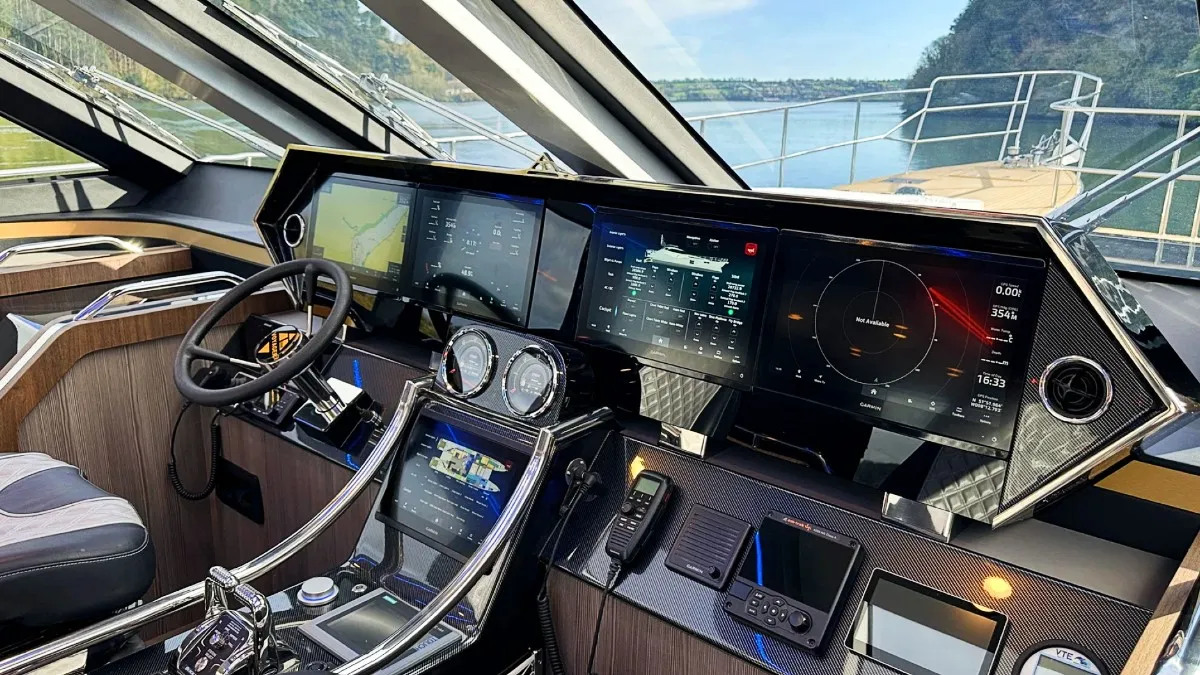
“It’s going to a client in the Middle East who plans to use it for just himself and his wife,” says Kowalski. The client has specified a full-width owner’s suite with a central, king-size bed and oversized his-and-hers bathrooms and closets in each hull. “He also wants to go fast—very fast,” Kowalski continues. “So we’ll install twin 2,000 hp MAN V12s, again with surface drives, and a central hydrofoil to reduce drag. The plan is for it to hit a top speed in excess of 100 kph.”
The new T-2000 is also designed to go the distance. With the 10,977 kilogram tanks, it has a range of more than 1,000 nautical miles at 55.2 kph, and 1,700 nautical miles at 28 kph. Throttle back to 19 kph and range increases to 3,000-plus nautical miles.
Much of this is down to the yacht’s symmetrical, semi-wave-piercing hulls, made of a carbon-fibre-composite construction, with inverted lower bow sections and a double-chine arrangement that projects spray clear of the boat. The hydrofoil in mid position also means that, at speed in calmish seas, the T-2000 rides with half its hull length out of the water.
To eliminate waves slamming into the bridge deck windshield, Kowalski moved the pilothouse farther back. It also makes for a sleeker profile, giving the T-2000 the look of a single-hull sportsyacht.
As for creature comforts, the main, open-plan salon features an L-shaped Corian-topped galley, with a U-shaped dinette opposite. To enjoy the action, there are bucket-style, shock-absorbing seats for the captain and copilot, a wraparound sofa on the port side, and a single bucket seat to starboard.
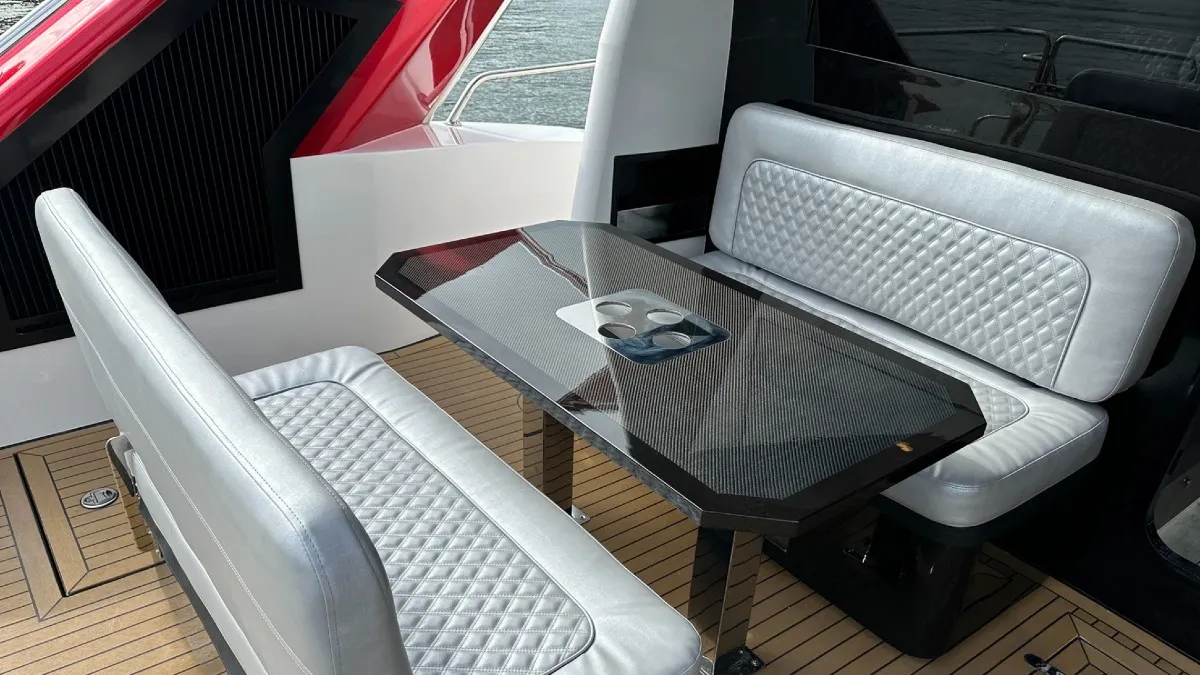
The entire helm area gets flooded with light courtesy of the four-panel, angled windshield and quartet of fixed skylights above. To see the boat’s hydrofoil in action, the bridge has a glass panel in the floor that’s also designed for viewing marine life below at night. Most of the windows have half-inch-thick toughened panels to shrug off cascading water.
In finer weather than typically found on coastal Ireland, the T-2000 has a small flybridge with a helm station and sun-lounge area up top, plus a covered stern cockpit with sofas and table for alfresco dining.
This storm-tested, metallic-red demonstrator is available for around $5 million.
You may also like.
10/09/2024
Six Senses Are Suddenly Everywhere. Inside the Luxury Resort’s Growing Global Empire
With 26 properties now open, another 43 to come, and the U.S. square in its sights, the rapidly growing wellness-focused resort and hotel brand is now asking the hard questions
If someone hit you in the head (hard) just before the pandemic, and you’re only waking up now, in the middle of 2024, you’ll have noticed some changes. For instance, the global proliferation of Six Senses hotels and resorts.
Once a relatively quiet group of wellness-focused Asian resorts for in-the-know Europeans, Six Senses is now in the midst of a breakneck opening spree with the U.S. square in its sights. Since 2019—when hotel giant IHG dropped $440 million in cash to acquire the operator’s then 16 hotels and resorts from private equity group Pegasus Capital Advisors—it’s grown to 26 urban hotels and destination resorts in 21 countries across four continents. (Its Vana resort in India is one of Robb Report‘s 50 best luxury hotels in the world).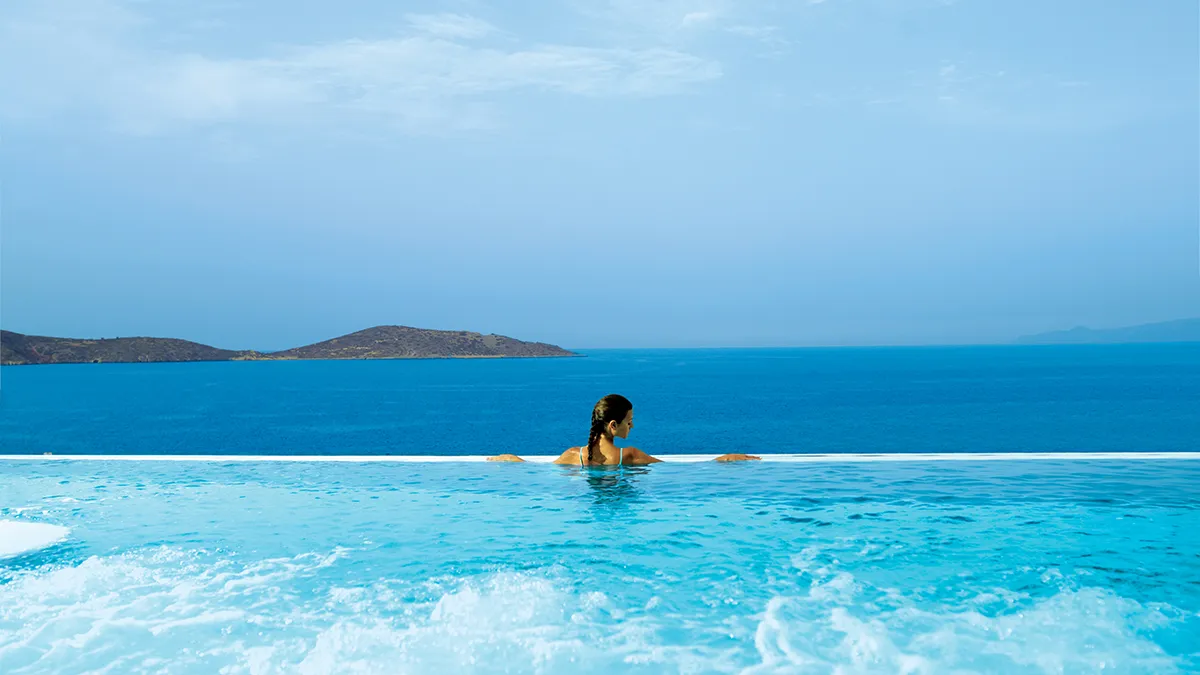
Blink again and that number may have doubled. By 2026, Six Senses, now the flagship brand of IHG’s luxury and lifestyle portfolio, hopes to have a shingle hanging in London, Bangkok, Dubai, Lisbon, Napa, and Tel Aviv. There are currently 43 Six Senses in the pipeline, which will extend Six Senses footprint from the Carolinas to Victoria Falls. Many of those new properties will come packed with branded residences.
So is Six Senses trying to conquer the world via ayurvedic medicine, longevity spa treatments, and mindfulness exercises?
“It’s been a hell of a ride,” admits CEO Neil Jacobs. “But the answer is no, and we have a real point of view on that.”
More on that point of view momentarily, but it’s worth pausing to note that despite his protestations, Jacobs comes to Six Senses with 14 years of experience with a hotel group that is arguable much more overtly interested in turning planet Earth into one massive 5-star hotel lobby: namely, the Four Seasons. As senior vice president of operations for the Four Seasons’s Asia Pacific region, he witnessed the company expand from roughly two dozen hotels into the 130-ish-address, Bill Gates– and Prince Al-Waleed bin Talal–owned leviathan of luxury it is today. The Four Seasons’s stated goal is 200 hotels. But Jacobs tells Robb Report it’s neither his or IHG’s intention to turn Six Senses into the Michael Kors of opulent wellness resorts.
“We think less is more,” he says of that aforementioned point of view. “Our competitors are all about growth. With Six Senses the conversation is very much the opposite of that. You’ve got to be really careful about what you do and where you go. I mean, we started with eight resorts in 2012. Then there were 11, and we got rid of two or three. Today, there are 26. So we’ve only opened 18 in nearly 12 years, really.”
Still, the Bangkok-based company is hurtling toward 60-plus properties, a number Jacobs says he is “comfortable” with. What happens beyond that is stickier.
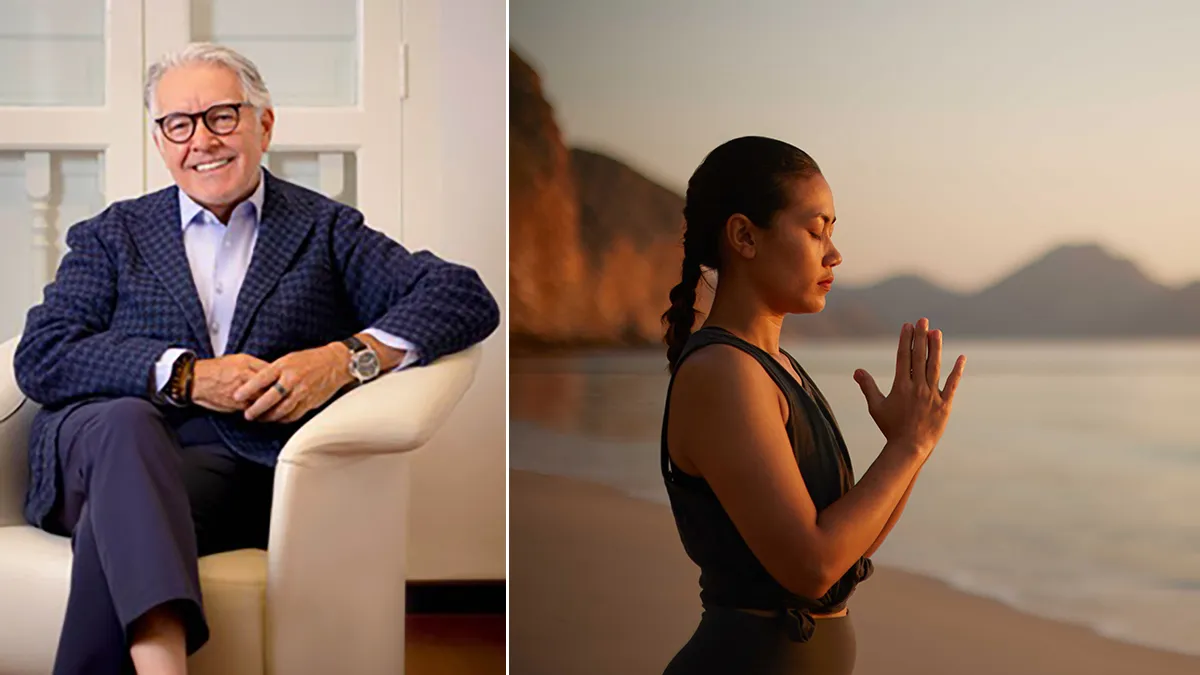
“We have four projects in Italy. We could do another five, but why?” says Jacobs. “Instead, let’s move to another country and spread, rather than just inundate the brand in one country, even though there’s places to do it. It’s a continual argument internally. We have some great places coming to Italy, but we don’t have Venice. So then my team says, ‘If we have a Venice deal, are you going to say, ‘Don’t do it?’ Good question. But the answer is, ‘maybe.’”
Whether it’s Six Senses, the Four Seasons, or Auberge (another brand that has seen a similarly rapid expansion), the answer to the question “When does quantity extinguish the spark of quality?” is worth at least a billion. But it’s also a problem that highlights the welcome fact that, despite the current slump, “luxury” is winning; it may have already won.
From fashion to travel, a growing share of businesses have repositioned themselves to serve the high-end consumer, as growing global wealth supports superior margins realized through the relative simplicity of a luxury rebrand. The affordable family resort of yesterday becomes the aspirational seaside playpen of today. As long as demand for luxury everything is here, deep-pocketed hotel groups will grow to meet it.
At the same time, the success of “luxury” creates a clear existential dilemma: If luxury becomes the standard setting, it is by definition no longer an indulgence, no longer a luxury. And as luxury becomes more gray and undifferentiated, the vague, eye-of-the-beholder quality that was once its strength, is now its liability.
It’s a problem that Jacobs feels that Six Senses was uniquely designed to address.
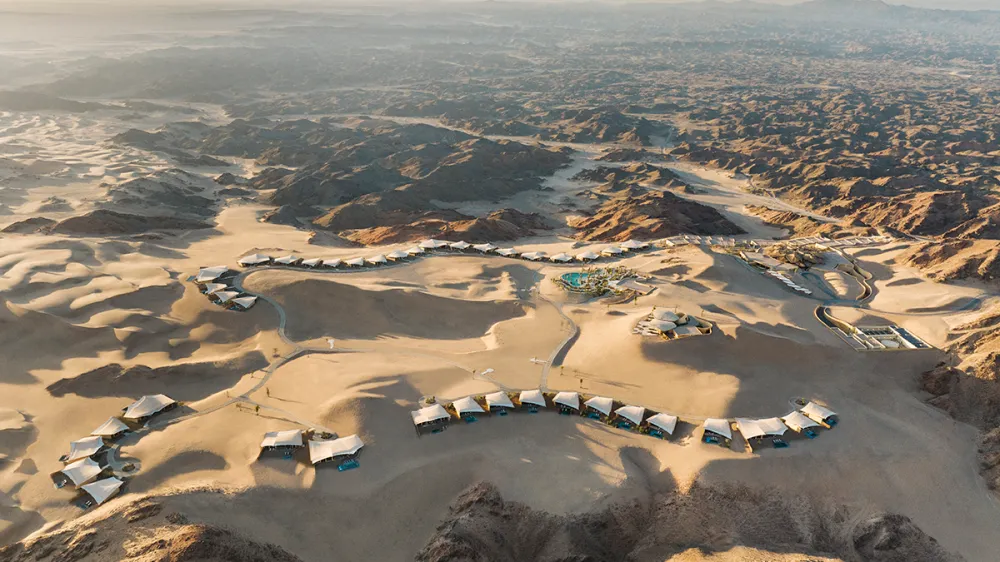
“That sixth sense in our name, we see it as intuition,” he says. “It’s interesting because one of our initiatives for this year in wellness is spiritual wellness. In the past, we’ve done a lot of yoga, we’ve done a lot of meditation, but we haven’t done a lot of overtly spiritual programs. We think the time is right.”
Those programs serving up, non-religious, lightly-woo spirituality on a silver platter roll out later this year and offer a key differentiator for the brand’s fastest growing customer base: Americans.
“Back in 2012, it was predominately a European customer, I’d say 85 percent,” says Jacobs. “There was no business coming from the U.S. Today, the U.S. is our number market, even though we don’t have anything open in the U.S.”
It’s not for lack of trying. Six Senses planned to open in Manhattan along the High Line in a doomed Bjarke Ingles–designed tower that was crushed by a Gambino crime family construction bribery scandal and the subsequent bankruptcy of its developer. Six Senses has since found a new site on 23rd St. between Seventh and Eighth Aves. in Chelsea, but is at least three years out.
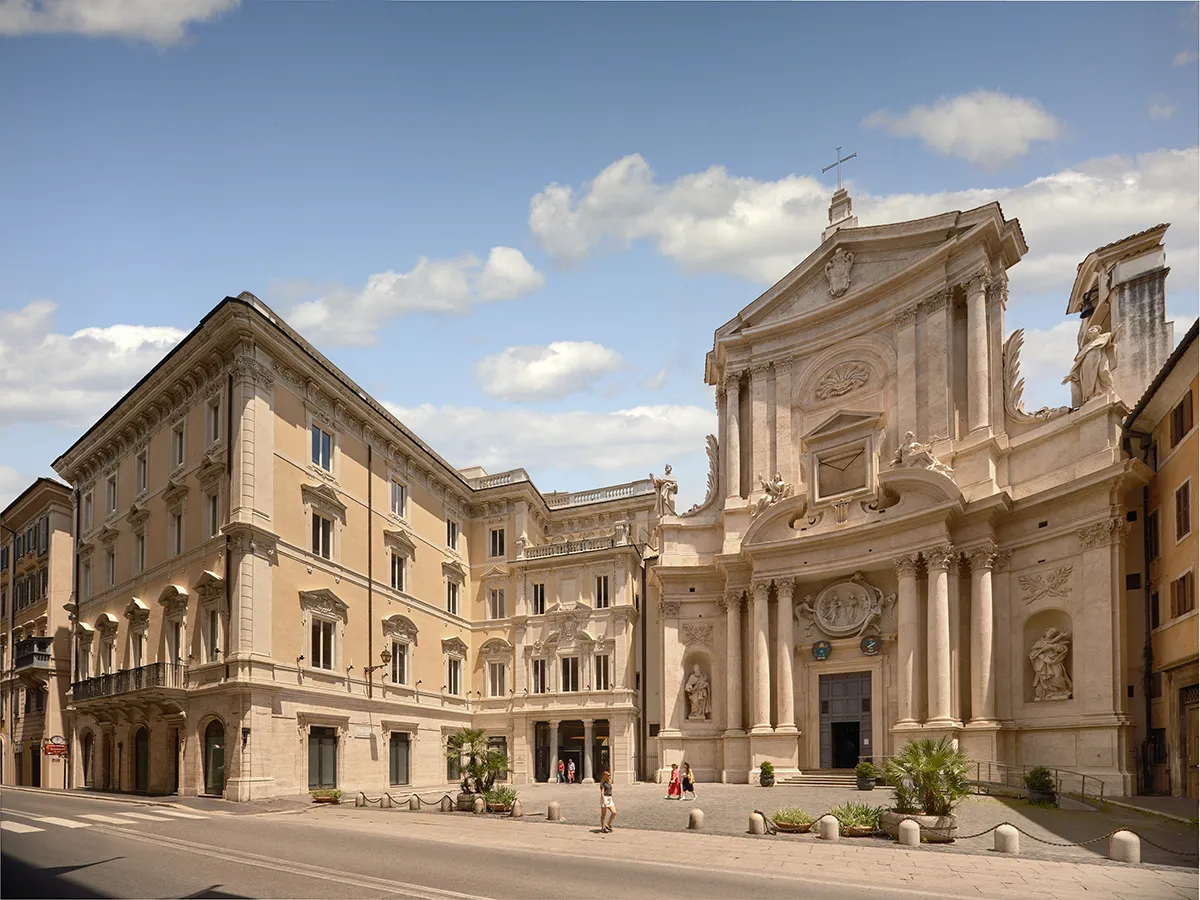
It’s having a better, if not altogether easier, time with the 236-acre farm in Hudson Valley in Upstate New York. The site of a failed “secret hotel” project, Six Senses snatched up the land for $20.2 million in 2022, making it some of the only real estate the brand owns (as with many brands, outside investors typically carry the deeds). Although it would be the first five-star flag in the region, the project has faced community opposition that could scuttle yet another attempt to create a footprint in the U.S.
“I don’t think it’s going to work,” Del LaMagna, whose property shares a border with the site, told the Hudson Valley Pilot. “[IHG] decided they wanted to be here, they started hiring good local people to figure it out, but this whole idea of exclusive resorts for rich people just doesn’t work up here.”
That’s a matter of opinion, but Six Senses plans for the U.S. extend far beyond the town of Clinton. Besides urban hotels in New York, L.A., and Miami, it will open a series of resorts, starting with a 500-acre estate on the edge of Napa and a multi-island project off the coast of South Carolina spanning Hilton Head, Daufuskie, and Bay Point. The gargantuan scale of those properties will eventually facilitate the festivals and retreats that the brand has been recently investing in.
“It’s a lot of yoga, a lot of spirituality, a lot of fun, a dance, a lot of movement,” he says. “Those kinds of festivals resonate with people.”
So if you’re just waking up, welcome to a world where Six Senses is everywhere all at once. But Jacobs hopes that by selecting “extraordinary properties” and by “demonstrating our values in a highly meaningful way” that the resorts will fit into the ecosystem like redwoods in a pine forest. Call it a sixth sense.
You may also like.
10/09/2024






